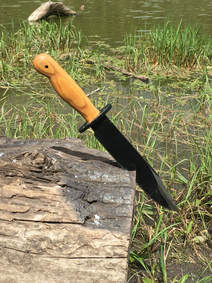
In our final installment on big knives, we at last come to what I think of as “my knife.” My last bowie is what I call my “battle blade.” The reason behind this has nothing to do with my expectation that I will need this knife in pitched battle with zombies . . . or anyone. The reference is a nod to Bill Bagwell, specifically to Chapter 32 of his book Bowies, Big Knives, and The Best of Battle Blades. Bagwell, writing in 2000, notes that there are relatively few “good” bowie knives on the market that satisfy his requirements for a proper “battle blade.” He says there are really (circa 2000) only two, the Cold Steel Trailmaster and the Camillus Bagwell series. The Trailmaster is a solid choice, according to Bagwell, but lacks certain qualities to make it an ideal choice. He approves of the Bagwell series, of course, since these are reproductions of his own custom knives.
Bagwell acknowledges that some might wish to design an effective battle blade without resorting to these two models, and his chapter is devoted to a project knife based on the Case Bowie. The Case bowie is large, with a wide blade and an imposing S-shaped guard that, as Bagwell says, is too large for utility and will simply snag on things. His chapter details how to grind the blade to restructure its overall shape and modify the guard and grip to create a serviceable “battle blade” on a budget. This is the approach I took for my bowie.
I began with a stock Cold Steel Trailmaster. It comes with a 9” blade, which meets Bagwell’s magic length requirement. The blade is not overly broad, but the false edge is too false. The grip is a nice coffin shape, but sadly is a rubberized material - I hate rubber grips. Finally, the sheath that it came with is a standard (that is to say, sub-standard) leather sheath with a belt loop attachment.
Based on Bagwell’s direction in his chapter, I set to work to transform my stock Trailmaster into my own “Battle blade.” The first order of business is to break out my handy-dandy Dremel tool and begin grinding a new profile for the false edge, or swage. I grind it down so that it’s slightly convex and put an edge on it. This gives me the capability of a back cut, so the top edge is sharpened. Unfortunately, this is tricky to sharpen because of the convex curvature of the edge - you can’t use a regular stone. As it stands I’ve gotten it passably sharp for the first inch and a half or so; beyond that the edge pales quickly.
Secondly, I cut off the awful rubber grip. I like the uniformity of the classic coffin shape, but I can’t abide a rubber grip on a knife. Luckily, the Trailmaster uses a real full tang (unlike the Natchez), which is both full length and relatively full width, so rehilting is a fairly straightforward affair. I used mesquite blanks. Rather than duplicating the coffin shape that came on the stock knife, I tried my hand making a shape that Randall knives terms their “Border Patrol” design. It worked out well, and I love the way it fits my hand. I intended to put a liner in the thong hole, but in the end I didn’t. Honestly, I figured I could always bore it out and add one later if I chose. The grip is held on solely by epoxy, which concerns me a bit about its longevity, but once again, I figure that if it becomes an issue at a later date I can drill through the tang and add pins. It’s not like I will be deployed in some faraway land when and if the handle fails me - I’ll almost certainly be no more than thirty minute hike to my Jeep, and I’ll just as certainly have a secondary knife as backup.
Finally, I had to address the sheath. I sent my knife off to Mike Sastre, owner of River City Sheaths. He is renowned in the bowie knife community for his kydex sheaths, and is one of the only makers who makes an old-style sheath with a stud for a belt rather than a loop. River City is one of the most famous sheath makers out there, so be advised that the lead time is considerable.
In the end, my “battle blade” represents pretty closely the design I would get from a custom maker. At 9 inches long, the blade is large enough to do most anything I might need, but not so large as to be unwieldy, as the larger bowies like the Musso or Natchez could be. The sharpened top clip is a bit controversial; it’s a feature that you wouldn’t want on a dedicated woods knife, but as a martial artist, I like the combative capabilities of it, even if I’ll never use the knife in combat. The wood handle fits my hand, and I think it’s far more attractive than any rubber could be. If I sold off the rest of my collection, this is the knife I would keep as a woods companion.
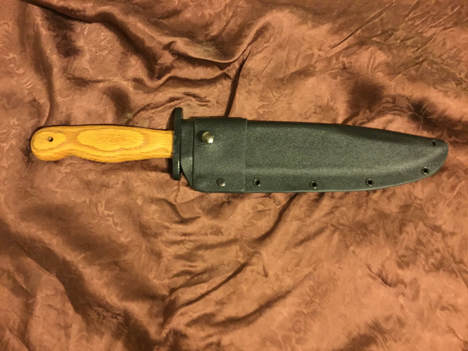
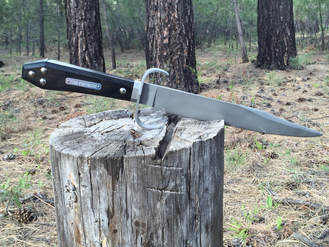
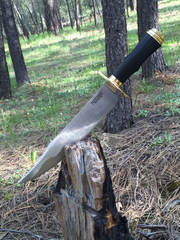
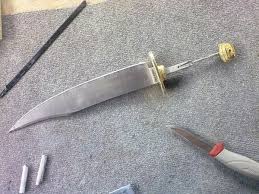

 RSS Feed
RSS Feed
